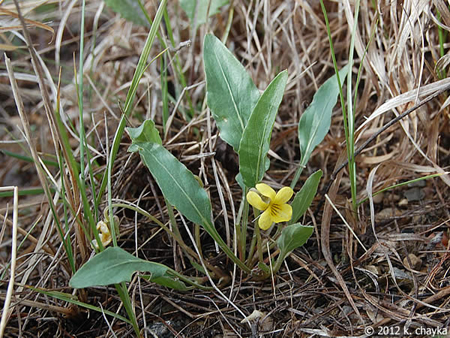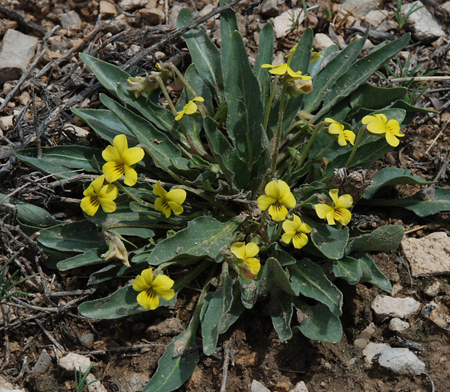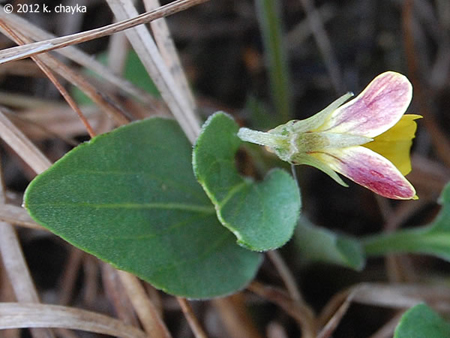Viola nuttallii Pursh
Common names:
Nuttall's Violet, Yellow Prairie Violet
Synonyms:
Viola nuttallii Pursh, Fl. Amer. sept. 1: 174. 1813; Crocion nuttallii (Pursh) Nieuwl. & Lunell, Amer. Midl. Naturalist 4: 478. 1916. TYPE: USA, Missouri, [no date], Herb. Nuttall s.n. (HOLOTYPE: PH00029269; POSSIBLE ISOTYPE: BM000617588; internet images!).
Description:
Caulescent perennials from thick rhizome, stems often declining at base, unbranched, solitary or multiple, ≤ 19 cm tall; stems, foliage and peduncles gray-green, puberulent; leaves cauline and basal, basal usually ≥ 2, cauline leaves well distributed along the stem; stipules free or weakly adnate, entire or weakly erose; leaves erect to ascending, leaf blades undivided, largest ≤ 53 × 12 mm, linear-lanceolate to lanceolate, base cuneate, margins subentire or with 1–3 shallow remote teeth, ciliolate, apex acute to obtuse; chasmogamous flower ≤ 15 mm; calyx glabrous or papillate-puberulent, eciliate or ciliolate; lowest sepals linear-lanceolate, acute; auricles prominent and entire or weakly erose, not elongating in fruit; corolla wholly yellow, upper petals purple or purple-brown on back; spur short-globose; lateral petals sparsely to densely bearded with clavate to reniform hairs, spurred petal glabrous; cleistogamous flowers lacking; capsule 6–9 mm, green drying tan, unspotted, glabrous or sparsely puberulent; seeds ca. 3 × 1 mm, medium brown, unspotted; 2n=24.
Similar species:
This species is distinctive in our region in its caulescent habit, gray-green puberulent foliage, narrow long linear-lanceolate to lanceolate leaf blades, and yellow corolla. Only V. vallicola var. vallicola, a species occurring within a few counties to the west of our range, could be confused with it. It differs from V. vallicola in its consistently puberulent foliage, longer narrower leaf blades with narrowly cuneate base, and larger medium brown seeds
Ecology:
Grasslands in our region, sagebrush and chaparral in the West.
Distribution:
Western North America and the Great Plains, w. MN to ID, south to w. KS, n. NM.
Rarity:
State listed in MN.
Phenology:
Chasmogamous flower May–June, chasmogamous fruit May–June (needs updating from additional specimens).
Affinities:
This species belongs to the Yellow Violet lineage, sect. Chamaemelanium Ging., in the Nuttallianae species group.
Hybrids:
None.
Comments:
Brainerd (1921b) and Alexander (1963) included Viola vallicola in a broadly delimited V. nuttallii but recognized V. praemorsa as a distinct species. Russell (1965) submerged all three species under V. nuttallii, and used V. vallicola as the source of the figure for his very broadly delineated V. nutallii. Scoggan (1978) and Gleason and Cronquist (1991) treated all three as varieties under V. nuttallii, while Little and McKinney (2015) maintained all three at species rank. Brainerd Baird (1942) maintained V. nuttallii and V. praemorsa and provided separate accounts of these but confusingly referred to V. vallicola as a “well recognized varying form” under V. nuttallii. Fabijan et al. (1988) conducted a comprehensive and illuminating taxonomic revision of the Nuttallianae group, presenting abundance macromorphological, morphometric, cytogenetic and biochemical evidence for maintaining all three as distinct and distinctive species in our region, with other taxa represented in areas further west. All three are accepted here as distinct and readily identifiable evolutionary species with different ploidy levels (the present species being tetraploid, V. vallicola diploid, and V. praemorsa hexaploid). Limited field studies and examinations of several representative herbarium collections have revealed no evidence of “intergradation” (with the several diagnostic characteristics in mind); any inter-ploidal hybrids would be expected to be wholly sterile at any rate. The present species and Viola vallicola range extensively across the Great Plains. All three species in the Nuttallianae group in our region are immediately recognizable by their yellow corollas, multiple stems, and leaves distinctly to much longer than broad (V. nuttallii and V. praemorsa with leaf blades cuneate at the base). The leaf blades of V. nuttallii alone distinguish it from the other two, being much longer and narrower and with more narrowly cuneate leaf base.
Literature Cited:
Alexander, E. J. 1963. Violaceae. In Gleason, H. A., The new Britton and Brown illustrated flora of the northeastern United States and adjacent Canada. Hafner Publishing Co., Inc., New York, NY. 552-567.
Brainerd, E. 1921b. Violets of North America. Vermont Agricultural Experiment Station Bulletin 224: 1-172.
Brainerd Baird, V. 1942. Wild violets of North America. University of California Press, Berkeley, CA.
Fabijan, D. M., J. G. Packer, and K. E. Denford. 1988. The taxonomy of the Viola nuttallii complex. Canadian Journal of Botany 65: 2562-2580.
Gleason, H. A. and A. Cronquist. 1991. Violaceae. In Manual of vascular plants of northeastern United States and adjacent Canada, 2nd ed. New York Botanical Garden, Bronx, NY. 157-163.
Little, R. J., and L. E. McKinney. 2015. Violaceae. Flora of North America: Cucurbitaceae to Droseraceae, 106. Oxford University Press, New York , NY.
Russell, N. H. 1965. Violets (Viola) of the central and eastern United States: An introductory survey. Sida 2: 1-113.
Scoggan, H. J. 1978. Violaceae. In Flora of Canada, Part 3–Dicotyledoneae (Saururaceae to Violaceae). National Museums of Canada. Ottawa, Canada. 1103-1115.

Chasmogamous flowering habit by Katy Chayka, "Minnesota Wildflowers" website

Chasmogamous flowering habit by Barry Breckling, CalPhotos, under Creative Commons license SA 3.0

Leaves by Katy Chayka, "Minnesota Wildflowers" website

Chasmogamous flower front view by Peter M. Dziuk, "Minnesota Wildflowers" website

Chasmogamous flower back/top view by Katy Chayka, "Minnesota Wildflowers" website

Map by the Biota of North America Program